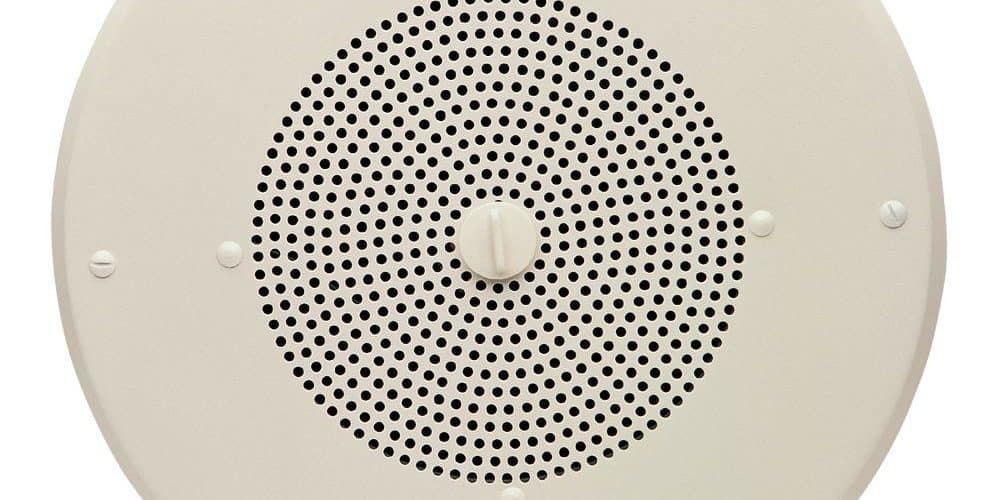Ceiling speakers are designed to be installed or hung on the ceiling. They make a resourceful alternative to regular speakers because they evenly distribute sound across the room, creating a better listening experience. Audio ceiling speakers also save space and are kept off the floor, making them the ideal choice for homes with pets or small children. Finally, wall ceiling speakers solve the issue of having exposed wires throughout the home, especially when trying to run speakers from the front of the room to the back. Maintenance free and out of sight, home ceiling speakers are a great choice for any home.
Types of Ceiling Mount Speakers: Recessed vs. Hanging Speakers
There are two types of surround ceiling speakers: recessed and hanging speakers. Recessed or in-ceiling speakers are mounted into the ceiling so that you only see the head of the speaker. Most recessed ceiling speakers are round in shape so that they blend in with recessed lighting and fixtures. The advantage to recessed ceiling speakers is that the wiring is hidden neatly in the ceiling and the grilles on the lights can be painted to blend in with the color of the ceiling. The disadvantage is that once installed, these ceiling lights are usually permanent because they are difficult to move.
The second type of ceiling speaker systems are hanging speakers which hang down from the ceiling using wire. Hanging speakers have a decorative casing that goes over them to blend in with the rest of the room’s décor and lighting. The advantage to hanging speakers is that the wires and casings can be tilted and moved around so that you can get the best quality sound. The disadvantage is that these speakers are quite apparent and do not have as sleek a look as recessed speakers.
What to Consider Before Purchasing Ceiling Stereo Speakers
Before choosing ceiling surround sound speakers for your home, first consider how you will be using them. Because of their versatility, home theater ceiling speakers can be installed in just about any room of the home, including kitchens, bathrooms, family rooms, home offices, and bedrooms. You will of course choose a different type of ceiling speaker to play soft background music in your bathroom versus speakers for a home entertainment system.
Also choose where you will be installing your ceiling mounted speakers and if recessed or hanging speakers are right for you. Most recessed speakers come in round shapes, but you can choose a different shape for a more modern or contemporary look. The paintable grilles also make it easy to blend the lights in with the ceiling or paint them a bold color to make them stand out. Hanging speakers have a cylinder shape but can be purchased with decorative casings.
Also keep in mind these three important factors when selecting round ceiling speakers: frequency response (Hz), power handling (watts) and sensitivity (dB). Frequency response is the range of human hearing that the speaker can reproduce. Look for a large range of frequency response so that more of the sounds will be captured and reproduced by the speakers. Note that human hearing has a range of 20 to 20,000 Hz so the frequency of speakers will fall somewhere in between these numbers.
The power handling is measured in watts and tells how much power the speaker will be able to handle. When selecting drop ceiling speakers, make sure that the speakers are rated higher than the power that is generated by your receiver or amplifier. The sensitivity of a speaker is measured in decibels (dB) and tells you how well your speakers are using the power generated by the amplifier. The higher the decibels, the less power is needed to deliver the same quality of sound.
Ceiling Speaker Installation
Before installing your speakers, you will need to have a room that is pre-wired or has had speaker wire run through it. If you don’t feel comfortable running wire through your attic, hire a professional to do this part of the project. Once completed, remove the speakers from the box and locate the template that indicates how big the hole in the ceiling needs to be for installation.
Locate the first area where you are mounting the speaker, then use a stud finder to locate the studs in the ceiling. Hold the template between the studs and trace the hole using a pencil. For hanging speakers, you will need to drill the brackets directly into a stud. For recessed speakers, cut out the hole using a drywall knife and use a tarp to catch any falling debris or insulation.
Making sure the attic is clear, place the speaker into the hole and attach the wires using the + and – terminals. For hanging speakers, cut out a small hole to feed the in-wall wires through without pinching them. Tighten the screws on the speaker and attach the grille cover, if using one. Cable clamps can be used to secure any exposed wiring to the wall.
Related Posts



